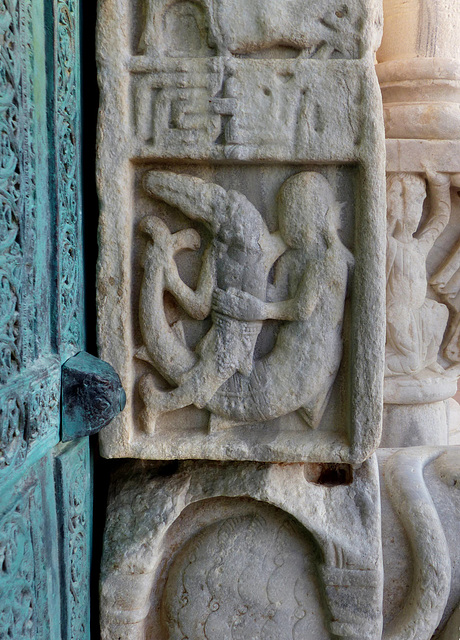Location
Lat, Lng: 41.282255, 16.418198
You can copy the above to your favourite mapping app.
Address: Casale Di Giano
You can copy the above to your favourite mapping app.
Address: Casale Di Giano
Keywords
Authorizations, license
-
Visible by: Everyone -
All rights reserved
-
104 visits
Trani - Cattedrale di San Nicola Pellegrino


Trani may have been founded by Greek settlers, but the known history starts late. After the fall of the Western Roman Empire, it was dominated by Lombards, Byzantines, Saracens and again Byzantines. With the conquest of southern Italy by the Normans and after 50 days of siege by Robert Guiscard´s troops, Trani became part of the Norman Empire in 1073.
Already under the Byzantines, Trani had become an important port for trade with the Orient. The heyday was in the time of the crusades in the 12th and 13th centuries, when crusaders and merchants mainly went to the Holy Land from Bari and Trani. It became an episcopal see in place of Canosa, destroyed by the Saracens. Frederick II promoted the Teutonic Knights and the Jewish community and built a massive castle. Under his rule, the city reached its highest point of wealth and prosperity.
The construction of the "Cattedrale di Trani" began in 1099, over the earlier church of "Santa Maria della Scala", which went back to the 4th century.
It is dedicated to "San Nicola Pellegrino". Bari had the relics of "Saint Nicholas of Myra". The Bishop of Trani could convince Pope Urban II to canonized a young pilgrim, who had died on his way to Jerusalem in Trani in 1094 from exhaustion. The new church was intended to house the relics of "Saint Nicholas the Pilgrim".
Pina Belli d'Elia ("Puglia romanica") is sure, that this cathedral is the most important of all romanic buildings in Apulia.
The building process started at the crypt. The "translatio corporis S. Nicolai ad novam Ecclediam" took place in 1142. As parts of the old church, dedicated to Virgin Mary, were maintained, the construction is pretty complex. The "Cattedrale di Trani" was completed around 1200, the construction of the campanile started by Nicolaus Sacerdos (see "Bitonto") and completed in the mid 14th century. In the20th century the bell tower was in such a bad state, that it was completely dismantled and rebuilt in the 1950s to avoid it collapsing.
The cathedral was built from white, local stones, that change the colour from white to yellowish and reddish, during the sunset. Some of the carvings around the central portal weathered, probably due to the near sea from where the wind blows.
Already under the Byzantines, Trani had become an important port for trade with the Orient. The heyday was in the time of the crusades in the 12th and 13th centuries, when crusaders and merchants mainly went to the Holy Land from Bari and Trani. It became an episcopal see in place of Canosa, destroyed by the Saracens. Frederick II promoted the Teutonic Knights and the Jewish community and built a massive castle. Under his rule, the city reached its highest point of wealth and prosperity.
The construction of the "Cattedrale di Trani" began in 1099, over the earlier church of "Santa Maria della Scala", which went back to the 4th century.
It is dedicated to "San Nicola Pellegrino". Bari had the relics of "Saint Nicholas of Myra". The Bishop of Trani could convince Pope Urban II to canonized a young pilgrim, who had died on his way to Jerusalem in Trani in 1094 from exhaustion. The new church was intended to house the relics of "Saint Nicholas the Pilgrim".
Pina Belli d'Elia ("Puglia romanica") is sure, that this cathedral is the most important of all romanic buildings in Apulia.
The building process started at the crypt. The "translatio corporis S. Nicolai ad novam Ecclediam" took place in 1142. As parts of the old church, dedicated to Virgin Mary, were maintained, the construction is pretty complex. The "Cattedrale di Trani" was completed around 1200, the construction of the campanile started by Nicolaus Sacerdos (see "Bitonto") and completed in the mid 14th century. In the20th century the bell tower was in such a bad state, that it was completely dismantled and rebuilt in the 1950s to avoid it collapsing.
The cathedral was built from white, local stones, that change the colour from white to yellowish and reddish, during the sunset. Some of the carvings around the central portal weathered, probably due to the near sea from where the wind blows.
- Keyboard shortcuts:
Jump to top
RSS feed- Latest comments - Subscribe to the comment feeds of this photo
- ipernity © 2007-2025
- Help & Contact
|
Club news
|
About ipernity
|
History |
ipernity Club & Prices |
Guide of good conduct
Donate | Group guidelines | Privacy policy | Terms of use | Statutes | In memoria -
Facebook
Twitter











Sign-in to write a comment.